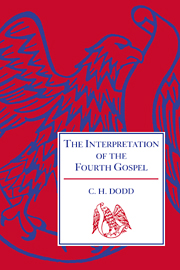Book contents
- Frontmatter
- Contents
- PART I THE BACKGROUND
- 1 The setting in early Christianity
- 2 The higher religion of Hellenism: the Hermetic literature
- 3 Hellenistic Judaism: Philo of Alexandria
- 4 Rabbinic Judaism
- 5 Gnosticism
- 6 Mandaism
- PART II LEADING IDEAS
- PART III ARGUMENT AND STRUCTURE
- APPENDIX: Some considerations upon the historical aspect of the Fourth Gospel
- Index Locorum
- Index Nominum
4 - Rabbinic Judaism
from PART I - THE BACKGROUND
Published online by Cambridge University Press: 10 December 2009
- Frontmatter
- Contents
- PART I THE BACKGROUND
- 1 The setting in early Christianity
- 2 The higher religion of Hellenism: the Hermetic literature
- 3 Hellenistic Judaism: Philo of Alexandria
- 4 Rabbinic Judaism
- 5 Gnosticism
- 6 Mandaism
- PART II LEADING IDEAS
- PART III ARGUMENT AND STRUCTURE
- APPENDIX: Some considerations upon the historical aspect of the Fourth Gospel
- Index Locorum
- Index Nominum
Summary
In the preceding chapters I have attempted a survey of some of the more important features in the Hellenistic background of the Fourth Gospel; for although Philo was himself a Jew, his place in the history of religious thought sets him more in the Greek than in the Hebrew succession. During the ascendancy of the Religionsgeschichtliche Schule in the latter years of the nineteenth century and the early years of the twentieth, it came to be generally held that the Fourth Gospel was to be understood almost entirely from a Hellenistic standpoint, and such Jewish, or Hebraic, elements as appear in it were consistently minimized. In recent years the balance has been redressed. This has been chiefly due to two factors.
First, the Semitic element in the language of the Fourth Gospel has been recognized and studied. Burney, The Aramaic Origin of the Fourth Gospel (1922), maintained that the Greek of the Gospel is only a thin disguise for Aramaic, that it is in fact translation Greek, the whole work having been originally written in Aramaic, which can often be recovered with reasonable certainty. Torrey, in his two books, The Four Gospels and Our Translated Gospels (1936), maintained a similar thesis for the whole four. The two writers naturally agree in many places in recognizing Aramaic idioms, but where they suggest retranslations they are often in disagreement about the original, and the cases of alleged mistranslation which both of them adduce rarely coincide. Matthew Black, An Aramaic Approach to the Gospels and Acts (1946), has criticized both.
- Type
- Chapter
- Information
- The Interpretation of the Fourth Gospel , pp. 74 - 96Publisher: Cambridge University PressPrint publication year: 1953

